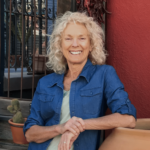
Waterloo Bridge – Sunlight in the Fog by Claude Monet
by Amy Weintraub
I want to unfold.
Let no place in me hold itself closed,
For where I am closed, I am false.
I want to stay clear in your sight.
—Rainer Maria Rilke
When an incident disturbs our peace of mind, we have choices. We can turn the conflict over and over in the mind, our thoughts spinning ever tighter, like the bands inside a golf ball, as anxiety increases. We can attempt to forget it, just toss the betrayal over the fence. Both of these choices close us down. A part of the mind constricts. If we follow the first course of action, obsessing about the incident, we can lose sleep, we can be distracted from our work, and we can distance ourselves from our intimates. Eventually, the knotted ball of pain is internalized in the body, joining in with a chronic tension in the shoulders or neck, or wherever we store stress. We know the effect of stress on body and mind—the increased risk of heart disease is just the most obvious. If we’re anxious and losing sleep over the issue, the insomnia can lead to depressed mood, and we can feel trapped in a seemingly unending cycle of anxiety and depression.
If on the other hand, we attempt to toss it over the fence, “Just let it go,” as a well-meaning friend might say, we may find ourselves raiding the carb cabinet in order not to feel. Or we might indulge in other forms of mindless, patterned behavior (watching too much television, surfing the internet, drugs, sex, alcohol) to numb the pain. Whether we worry and obsess, or try to bury it under the rug, we are closing off parts of ourselves. When we are feeling stressed or scared or misunderstood, it’s easy for those closed off, defended parts to take the lead. We might appear rigid or protected, or defensive or falsely congenial. Those closed-down parts within us are there for good reason. They’ve been wounded and they want to protect us from further hurt. Sometimes they do their job so well, that we feel nothing at all. Rilke’s quote speaks for our wise and compassionate inner knowing that wants those wounded, shut-down parts to know that it’s safe to release. But how do we clear? How do we stay open through the pain of injustice and betrayal?
One way to do that is to cultivate a yoga practice that helps us clear the space within, which means we pay attention to sensation and breath as we practice, watching without judgment all that arises. It means we use pranayama breathing practices to create a sense of spaciousness within, so we’re less constricted around the story. If we simply try to meditate without clearing the space with movement (asana), breathing practice (pranayama), imagery (bhavana), mudra (hand gesture) or sound (mantra), it may feel impossible to sit through the discomfort of our thoughts without spiraling into a darker place. We might rise from the cushion, feeling just the opposite of Rilke’s expressed yearning. Instead, of the unfolded, open, clarity we seek, we feel as though the fog has rolled in.
I know of no better practice to shine a light through the fog, opening and unfolding us to the clear space beneath the current pain than the LifeForce Yoga Bliss Meditation for Conflict. This practice gives the busy mind a bone to gnaw on, so it’s less likely to get caught in the loop of angry or self-judging thoughts. We engage the energy centers, known as the chakras, with breath, visualization, mantra, and gesture. It’s a short meditation practice that can shift the mood, reminding us that though the feelings and thoughts may remain, we are so much more than our ruminations. It can create a spacious awareness of grounded presence where mindfulness naturally arises—a beautiful portal into a longer meditation.
The practice:
- Sit comfortably with the spine erect or lie down. Begin to notice the breath—first at your nostrils, as it flows in and out. Next notice how the belly is receiving the breath. And then notice if the chest is responding to the breath. Welcome the breath, wherever it’s landing.
- Now imagine that you are inhaling from your feet to the crown of your head. Imagine that you are exhaling to your feet. As you inhale to your crown, say to yourself silently, “I am.” As you exhale to your feet, say to yourself silently, “here.” Repeat several times, varying it by exhaling to the feet with the word “grounded.”
- Inhale to the crown with the words “I am.” Exhale to the brow point with the word “clarity.” Repeat several times.
- Inhale to the crown with the words “I am.” Exhale to the heart with the word, “compassion.” Repeat several times.
- Now visualize what you imagine to be the source of the conflict you are facing. Inhale to the crown with the words “I am.” Exhale to the solar plexus with the word “courage.” Repeat several times.
- Now visualize an image for calm strength. This can be a scene from nature, an animal, or a powerful image of yourself. As you hold this image in your heart’s mind, inhale to the crown with the words “I am.” Exhale to the solar plexus with the words “calm strength.” Repeat several times.
- This time, as you inhale, extend your arms in front of your solar plexus as you visualize the image you have cultivated for calm strength or, if an image didn’t readily arise, the words “calm strength.” If it’s comfortable, pause with the image in your heart’s mind for a heartbeat or two. Then draw your hands so they fold over your solar plexus with the mantra “Ma-ha-ra.” Do this three times.
- Take this same image or the words, and do the same breathing pattern, but this time, draw your hands folded over your heart with the mantra “Ma-ha-ya.”
- With your hands on your heart, inhale to the crown with the words “I am.” Exhale to the heart with the word “love.”
- Give your heart a rock, the image of calm strength, on the altar of your heart.
Now you can remain in meditation or if there’s a desire to take a harmonizing action that is related to the conflict, you might explore that.
For other practices, both calming and energizing, that can help you manage your mood, whether it’s anxious or depressed, please join me at one of my workshops or trainings live online or find another version of the Bliss Meditation Practice and 51 other practices in my new card deck, YOGA FOR YOUR MOOD, at www.amyweintraub.com
 Amy Weintraub, MFA, C-IAYT, is the founder of the LifeForce Yoga® Healing Institute, an acclaimed yoga therapist, and a pioneer in the filed of yoga and mental health. Author of the best-selling Yoga for Depression and Yoga Skills for Therapists, she teaches and guides thousand of practitioners and therapists around the world. Her novel Temple Dancer was released in 2020 to excellent reviews. She thrives in Tucson, Arizona, where she mountain bikes, dancers, writes, and creates. Follow Amy on INSTAGRAM, FACEBOOK, YOUTUBE , TWITTER, GOODREADS , AMAZON
Amy Weintraub, MFA, C-IAYT, is the founder of the LifeForce Yoga® Healing Institute, an acclaimed yoga therapist, and a pioneer in the filed of yoga and mental health. Author of the best-selling Yoga for Depression and Yoga Skills for Therapists, she teaches and guides thousand of practitioners and therapists around the world. Her novel Temple Dancer was released in 2020 to excellent reviews. She thrives in Tucson, Arizona, where she mountain bikes, dancers, writes, and creates. Follow Amy on INSTAGRAM, FACEBOOK, YOUTUBE , TWITTER, GOODREADS , AMAZON
Follow Yoga for Healthy Aging on Facebook ° To order Yoga for Healthy Aging: A Guide to Lifelong Well-Being, go to Amazon, Shambhala, Indie Bound or your local bookstore.


Leave A Comment